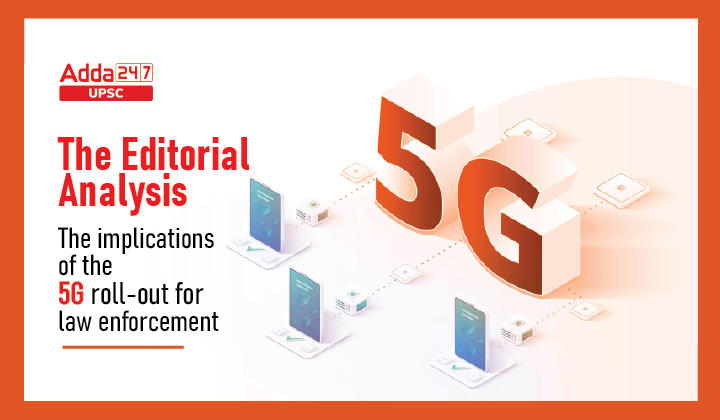Table of Contents
The Editorial Analysis- The implications of the 5G roll-out for law enforcement- Relevance for UPSC Exam
General Studies III- Science and Technology.
In News
Prime Minister Narendra Modi recently announced that 5G deployment in India will commence sooner than expected.
Ensuring security
- The 5G roll-out is set to enhance efficiency, productivity, and security by helping the police access critical information in real-time and nab criminals.
- 5G has high bandwidth and low latency, so its adoption would ensure the best performance of police devices such as body cams, facial recognition technology, automatic number-plate recognition, drones, and CCTVs.
- 5G promises to transmit clearer images which will simplify the task of the police who, at present, often look at hazy images from devices and attempt to decipher them while working on cases.
- The increased storage capacity promised by 5G will allow the police to streamline their investigation methods.
- 5G will also allow rapid and secure communication within the organization as well as between civilians and emergency responders.
- With 5G, the police can remotely access and analyze crime data and information from other infrastructure such as traffic lights.
Challenges in adopting 5G
- The government and telecommunication companies must first ensure that law enforcement agencies have the necessary infrastructure to take full advantage of all that 5G can offer.
- Most police systems are outdated and may not be compatible with 5G. To bridge this technology gap, the police must invest in modern tools, software and infrastructure.
Cyber security concerns
- Deploying 5G when we have a shaky cyber security foundation is like erecting a structure on soft sand.
- Since 5G is a software-defined digital routing making it susceptible to cyber threats such as botnet attacks, man-in-the-middle attacks, and distributed denial-of-service (DDoS) overloads.
- Besides, as 5G lacks end-to-end encryption, hackers can plot their attacks more precisely and perpetrate cybercrimes by hacking into systems or disseminating illegal content.
- The bandwidth expansion due to 5G will enable criminals to embezzle data bases easily and with time, as 5G connects with additional devices, the frequency of attacks could increase.
- 5G may also make it easier for criminals to perpetrate cyber bullying.
- Criminal groups may be able to easily coordinate DDoS onslaughts because of the real-time communication capabilities between multiple criminal groups. They could also hack into Internet-of-Things (IoT) devices and remotely commit crimes. Security patching of all IoT devices may eventually become necessary.
- Terrorists, too, could benefit from 5G as the high speed would allow them to execute attacks more rapidly and precisely.
- With 5G, terrorists can plan attacks without having to travel physically or use telephones, which could leave a trail for law enforcement agencies to act on.
What can be done?
- Authorities will have to adopt measures to hinder crimes facilitated by 5G technology.
- First, the police will need to be trained so that they recognize new 5G-enabled crimes.
- Second, training programmes focusing on such crimes must be developed. This includes identifying potential scenarios for new types of crimes and their prevention.
- Third, the government and telecom companies could think of setting up a 5G crime monitoring task force to monitor and identify new crimes and develop countermeasures.
- Fourth, it is imperative to create regulations that make it a crime for people to use 5G technology to commit crimes. Such a regulation could help prevent criminals from using stolen or counterfeit equipment since telecom companies will be able to track the location of the equipment and shut it down remotely.
- Fifth, regulations may also require telecom companies to allow police officers access to their equipment to track the location of victims and perpetrators of 5G-facilitated crimes for countermeasures. These countermeasures may not only safeguard critical infrastructure but also defend private citizens from cyber-attacks using 5G technology.
- Finally, law enforcement agencies will have to evolve strategies to identify victims of 5G-facilitated crimes, locate them and act against the perpetrators of such crimes.
Conclusion
The 5G roll-out will be a game-changer for law enforcement agencies. It will enable the police fight crime effectively. At the same time, criminal use of 5G is inevitable. In this context, the recent recommendation of the Telecom Regulatory Authority of India to the government to develop a national road map for India to implement 5G in the best possible manner should encompass law enforcement requirements.




 TSPSC Group 1 Question Paper 2024, Downl...
TSPSC Group 1 Question Paper 2024, Downl...
 TSPSC Group 1 Answer key 2024 Out, Downl...
TSPSC Group 1 Answer key 2024 Out, Downl...
 UPSC Prelims 2024 Question Paper, Downlo...
UPSC Prelims 2024 Question Paper, Downlo...




